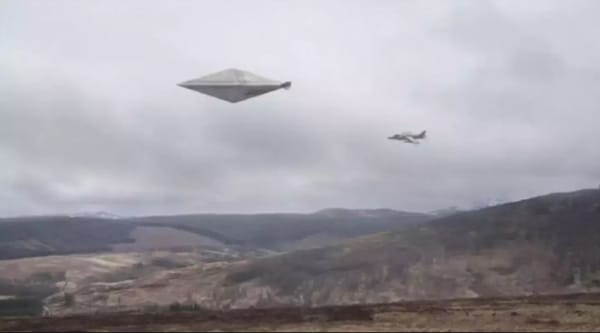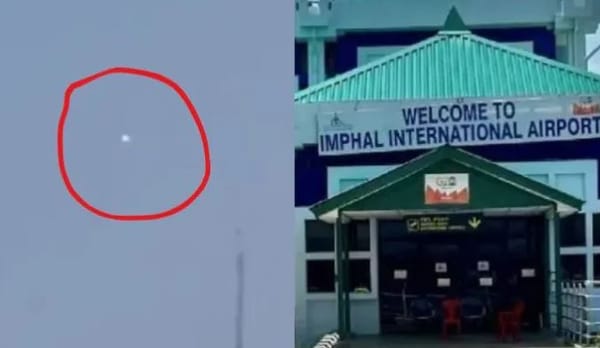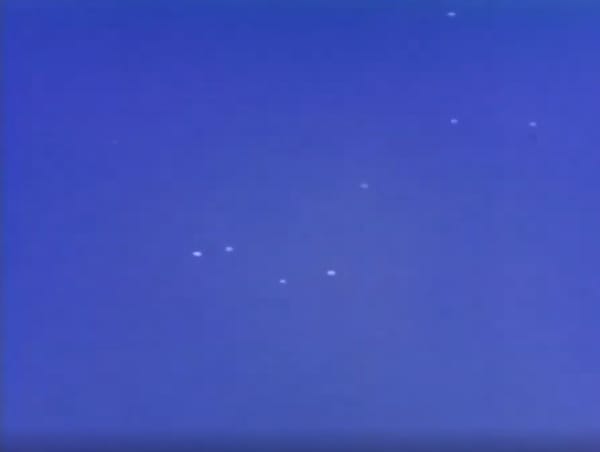The 2003 Aguadilla, Puerto Rico Incident

On April 25, 2003, an intriguing UFO sighting unfolded over Aguadilla, Puerto Rico, captured by the thermal imaging camera of a U.S. Customs and Border Protection (CBP) aircraft. The footage from this encounter has become a focal point of UFO research and public interest due to its remarkable content and the unanswered questions it raises. The video shows a glowing, unidentified object maneuvering at high speeds and exhibiting a particularly unusual behavior: it appears to enter the ocean without losing velocity, an extraordinary feature that has sparked considerable debate.
The Aguadilla incident has gained prominence not only for the quality of the video evidence but also for the lack of clear explanations provided by authorities. Despite various theories ranging from advanced drones to potential natural phenomena, the exact nature of the object remains unresolved. The incident was initially classified, and the release of the video and related documents only added to the intrigue, revealing a complex case with many layers yet to be fully understood.
This article delves into the details of the Aguadilla sighting, exploring the context and specifics of the footage, the implications of the object's underwater maneuver, and the ongoing investigation into this captivating event. By examining the available data, witness statements, and expert analyses, we aim to provide a comprehensive overview of one of the most enigmatic UFO encounters documented in recent history.
The Incident
On April 25, 2003, a U.S. Customs and Border Protection (CBP) aircraft patrolling the skies near Aguadilla, Puerto Rico, encountered an anomalous flying object that has since become one of the most compelling UFO cases of the 21st century. The incident, which was recorded by the aircraft’s forward-looking infrared (FLIR) camera, provides a rare and detailed view of an unidentified aerial phenomenon.
The Sighting
The encounter began in the early hours of the evening when the CBP aircraft was conducting routine surveillance operations over the Aguadilla area. The FLIR camera, designed to detect heat signatures, captured the object as it appeared on the screen. The initial footage shows a bright, glowing object moving at high speed across the camera's field of view.
Witnesses from the CBP crew reported that the object was initially spotted flying at a high altitude and moving with a speed that seemed to defy the capabilities of known aircraft. The object was tracked for several minutes as it traversed various landscapes, including urban areas, roads, and open fields.
Object Behavior
One of the most striking aspects of the Aguadilla sighting is the object's behavior as it approached the ocean. The footage shows the craft making a dramatic descent towards the water without any noticeable reduction in speed. Unlike conventional aircraft or known aerial drones, the object did not slow down as it entered the ocean, a behavior that is highly unusual and has led to significant debate.
The object’s entry into the water is captured in the video as it appears to maintain its speed and trajectory. It continues moving beneath the surface, which is particularly intriguing given that no known technology at the time was capable of transitioning from air to underwater travel at such speeds without losing momentum.
Analysis and Investigations
The video footage was subject to analysis by several experts and organizations. Various hypotheses were proposed to explain the object's nature and behavior. Some suggested that it could be a type of advanced drone or a military test vehicle, though no specific technology was identified that matched the object's performance.
Further scrutiny involved radar data from the CBP aircraft and other sources. However, the radar information did not provide conclusive evidence regarding the object's size or exact location after it entered the water. The radar data indicated that the object’s movement did not correspond with any known aircraft or conventional drones operating in the region.
Public and Official Reactions
The Aguadilla incident gained attention when the video was eventually released to the public. The release came as part of a broader effort to disclose previously classified materials related to unidentified aerial phenomena (UAPs). The footage has been widely discussed and analyzed within the UFO research community, leading to various interpretations and theories.
Officials from CBP and other governmental bodies involved in the incident have remained largely silent, providing minimal additional information. This lack of clarity has fueled speculation and interest among researchers, UFO enthusiasts, and the general public.
The incident’s impact extends beyond the immediate sighting, contributing to ongoing discussions about the nature of unidentified aerial phenomena and the capabilities of advanced technology. The footage remains one of the most compelling pieces of evidence in the modern study of UFOs, raising questions about what might be possible with future technological advancements and discoveries.
In summary, the Aguadilla incident presents a fascinating case study in UFO research, characterized by its high-quality visual documentation and the extraordinary behavior of the unidentified object. The lack of definitive explanations and the object's unique characteristics continue to inspire inquiry and debate within the field of ufology.
Aftermath
The Aguadilla UFO incident, captured on April 25, 2003, has had significant implications for both public understanding and governmental responses to unidentified aerial phenomena. The aftermath of the event has been marked by a combination of official silence, continued public interest, and ongoing investigations.
Release and Public Reaction
For years, the video footage from the Aguadilla incident remained classified and largely under wraps. It wasn't until recent years that the footage, along with related documents, was declassified and made available to the public. The release came amid a broader push for transparency regarding UFOs and UAPs, reflecting growing interest and demands for more information on these mysterious phenomena.
The public release of the video sparked considerable interest and debate within the UFO research community and among the general public. The footage’s dramatic and unexplained nature, particularly the object’s apparent underwater maneuver, drew attention from both amateur and professional researchers. The incident has been featured in numerous documentaries, articles, and discussions, becoming a key case study in the ongoing examination of unidentified aerial phenomena.
Government and Military Response
Following the release of the Aguadilla footage, the response from government and military officials has been notably restrained. While there has been acknowledgment of the incident, official statements have been sparse. U.S. Customs and Border Protection (CBP) and other involved agencies have provided limited additional information, and no conclusive explanations have been offered regarding the identity or nature of the object.
The event has contributed to the broader discourse on UAPs and has been referenced in the context of increased governmental interest in understanding and addressing unidentified aerial threats. The U.S. government’s recent efforts to investigate and disclose information about UAPs have brought renewed focus to incidents like Aguadilla, highlighting the challenges and complexities of identifying and addressing unknown aerial phenomena.
Impact on UFO Research
The Aguadilla incident has become a significant case within the UFO research community due to the quality of the visual evidence and the unanswered questions it presents. Researchers have continued to analyze the footage and data, seeking to understand the object’s behavior and technology. Various theories have been proposed, ranging from advanced experimental drones to potential extraterrestrial craft, but no definitive conclusions have been reached.
The case has also influenced ongoing discussions about the nature of UAPs and the need for continued research and transparency. It has been cited in debates about the potential for new technologies and the implications of unexplained aerial phenomena for national security and scientific understanding.
Continued Investigations and Speculations
Interest in the Aguadilla incident remains high, with ongoing investigations and analyses by independent researchers and ufologists. The case is often referenced in discussions about the broader context of UAPs and the challenges associated with investigating and understanding these phenomena.
The incident has also contributed to the broader narrative of governmental secrecy and the push for greater transparency. Advocates for disclosure and research into UAPs often use cases like Aguadilla to highlight the need for more open investigations and the importance of addressing public curiosity and concerns about unexplained aerial phenomena.
In summary, the aftermath of the Aguadilla incident reflects a blend of public fascination, governmental reticence, and ongoing research. The case remains a pivotal example of the complexities and challenges in understanding unidentified aerial phenomena, continuing to influence discussions and investigations in the field of ufology.
Conclusion
The Aguadilla incident of April 25, 2003, stands as one of the most compelling and enigmatic cases in modern UFO research. Captured on video by a U.S. Customs and Border Protection aircraft, the footage reveals an unidentified object performing extraordinary maneuvers, including a dramatic entry into the ocean without apparent loss of speed. This striking feature has fueled considerable debate and speculation, highlighting the broader complexities involved in investigating unidentified aerial phenomena.
Despite the high-quality visual evidence and detailed analysis, the precise nature of the object remains unresolved. Governmental responses have been limited, and official explanations have yet to fully address the questions raised by the footage. This ongoing uncertainty has only deepened public interest and heightened the demand for further transparency and investigation.
The Aguadilla incident has had a lasting impact on both public perception and the field of UFO research. It serves as a potent reminder of the challenges faced in understanding and identifying unexplained aerial phenomena. The case has contributed to broader discussions about the nature of UAPs, the capabilities of modern technology, and the need for continued research and openness in addressing these mysterious occurrences.
As we continue to explore the mysteries of our skies, the Aguadilla incident remains a crucial piece of the puzzle, driving home the importance of rigorous investigation and open dialogue. The questions it raises about advanced technologies, potential threats, and the limits of our current understanding underscore the need for ongoing inquiry and a commitment to uncovering the truth behind unidentified aerial phenomena.
In essence, the Aguadilla incident encapsulates the intrigue and complexity of UFO research, challenging us to look beyond conventional explanations and consider the broader implications of the unknown. Its legacy will likely influence future investigations and discussions, serving as a testament to the enduring mystery and fascination surrounding the unexplained.



